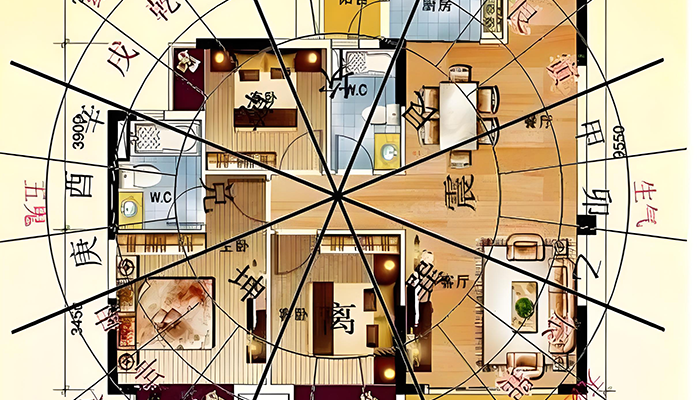Feng Shui and Energy Flow Guide – Integrating Eastern Wisdom with Western Science for Optimal Living Environments
A home is more than just shelter; it’s an energy field that influences our health, wealth, and harmony. From Eastern Feng Shui to Western environmental psychology, humanity has always sought to create optimal living spaces.
“The dwelling is the hub of yin and yang, the framework of human relations. Unless one is widely learned and wise, one cannot comprehend this way. People make dwellings their homes. If the dwelling is peaceful, the family will be prosperous for generations; if not, the clan will decline and perish.” — “Yellow Emperor’s Classic of Dwelling”
Modern home design requires integrating Eastern Feng Shui wisdom with Western environmental science from the very beginning of architectural planning to create truly harmonious, healthy, and prosperous living spaces.
1. External Environment and Site Selection
An ideal residential environment should harmonize with the surrounding natural landscape. Both the “Four Celestial Animals” pattern in Eastern Feng Shui and the “Prospect and Refuge” theory in Western environmental psychology emphasize balance and protection.
Ideal External Environment Characteristics:
- Green Dragon on left, White Tiger on right: Slightly higher structures or hills on the left (Green Dragon), slightly lower structures or roads on the right (White Tiger), forming a protective layout
- Red Phoenix in front, Black Tortoise behind: Open space or water in front (Red Phoenix), supporting mountain or tall structures behind (Black Tortoise)
- Road directions: Water flow in the east is auspicious; major road in the east indicates poverty; major road in the west is lucky; major road in the south brings wealth; major road in the north is inauspicious
- Topographical features: North-south longer than east-west is auspicious; east-west longer than north-south is initially inauspicious but later becomes favorable
Traditional Land Assessment Method: Soil Weighing
Take soil from the foundation site, shape it into a 4.2cm cube, and weigh it:
- Over 9 liang (about 337.5g): Highly auspicious land
- 5-6 liang (about 187.5-225g): Moderately auspicious land
- 4 liang and below (about 150g): Inauspicious land, unsuitable for construction
External Environments to Avoid:
- Water pit directly in front of entrance: May lead to family breakdown
- Large tree blocking main entrance: Obstructs energy flow
- Entrance facing northeast: Traditionally believed to attract negative energy
- Multiple roads pointing directly at home: Creates overly intense energy
2. Main Door Design and Energy Entrance
The main door is the “mouth of chi” (energy entrance) of a home, and its position and design are crucial to the quality of energy throughout the residence.
Eastern Feng Shui Perspective
- The area in front of the door (Ming Tang) should be open and tidy
- Door on the left side (Green Dragon position) is encouraged; door on the right side (White Tiger position) should be avoided
- Door panels should be equal in size; larger left panel may lead to instability, larger right panel may lead to loneliness
- Avoid straight roads pointing at the door, dead trees, utility poles, etc.
Western Environmental Psychology Perspective
- Entrance should be clearly visible, providing a sense of security
- Transition space in front of door helps psychological adjustment
- Door design should reflect residents’ identity and values
- Good lighting and clear pathways guide visitors
Professional Advice: Determine the optimal door position during the planning stage, considering local climate, sun path, and prevailing winds to create an entrance design that follows Feng Shui principles while being practical.
3. Bedroom and Sleeping Area Planning
The sleeping area is a key space for energy restoration, and its orientation and layout directly affect residents’ health and mental state.
Feng Shui Principles for Bed Placement:
- Bed matching life destiny: East group people (elements water, wood, fire) should place beds in east, south, southeast, or north directions; West group people (elements earth, metal) should place beds in west, northwest, southwest, or northeast directions
- Fu Wei principle: Determine optimal bed direction based on personal Kua number
- Bed headboard taboos:
- Avoid beams above the bed
- Avoid direct alignment with door
- Avoid proximity to windows
- Avoid direct alignment with mirrors
Eastern Bed Direction Guide
- Zhen Wood命: Fu Wei in East
- Xun Wood命: Fu Wei in Southeast
- Li Fire命: Fu Wei in South
- Kan Water命: Fu Wei in North
- Kun Earth命: Fu Wei in Southwest
- Gen Earth命: Fu Wei in Northeast
- Qian Metal命: Fu Wei in Northwest
- Dui Metal命: Fu Wei in West
Western Sleep Environment Optimization
- Bed position should allow view of door but not directly aligned
- Avoid placing bed under windows or in drafty areas
- Ensure space on both sides of bed for easy access
- Choose supportive mattress and comfortable bedding
- Control light and noise levels in bedroom
4. Overall Layout and Energy Flow
Successful home design requires comprehensive consideration of the interrelationships between spaces, ensuring smooth energy flow throughout the residence.
Key Design Principles:
- Clear functional zoning: Separation of active and quiet areas, clear boundaries between public and private spaces
- Reasonable circulation: Natural, unobstructed movement paths indoors
- Light and ventilation: Maximize use of natural light and ventilation
- Material selection: Use natural, eco-friendly materials to create healthy indoor environments
- Color coordination: Choose appropriate colors based on space function and direction
Professional Advice: Consult professional Feng Shui masters and environmental designers during the initial architectural design phase to integrate traditional wisdom with modern science, creating truly livable harmonious spaces. A home is a long-term investment, and the cost of professional consultation upfront is well worth it compared to the overall construction cost and long-term living experience.

